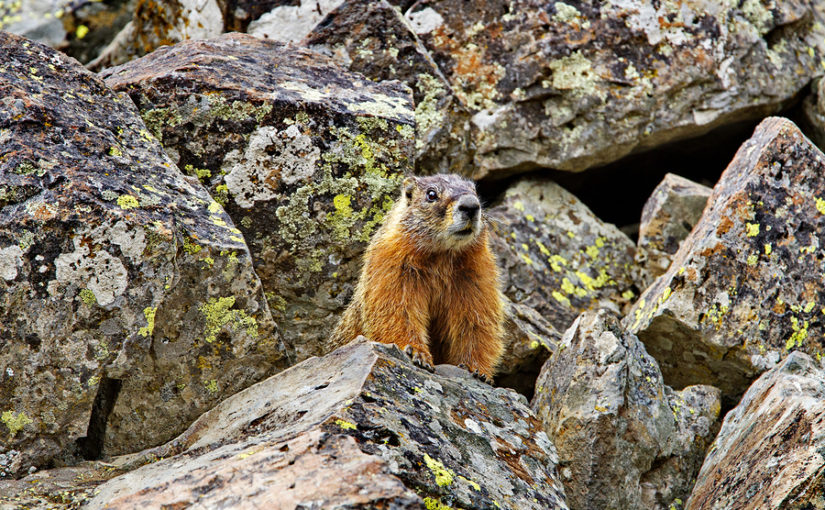Yellow bellied Marmot (Marmota Flaviventris)
Description
Marmots also known as rock chucks and whistle-pigs are a large bodied squirrel. Their tails are short and bushy. The pelts are a wide variety colors ranging from yellow-brown to tawny and is made up a long cource hairs, shorter guard hairs and soft woolly underfur. The tips of the course guard hairs are heavely frosted color while other hairs have dark bands, giving them a salt and peper look. The bellies ususally are yellow to kakhi colored.
Biology
Marmots measure in length 700 mm to 1002 mm nose to tail and weigh 1.6 – 5.2 kg. They live at elevations of 5400. ft to 8000 ft. They range from the subalpine and montaine meadows to the alpine tundras. They prefer foothills, rocky areas with places to hide, canyons country and rocky boulder terraine.
They eat a variety of vegetation (Forbes) such as dandelions, cow snip, chiming bells, cinquefoil and brome. They eat flowers such as columbine, lupine and larkspur but avoid the toxic parts of the plant where the chemical concentration is greatest and Seeds are eaten in the late summer. Some cannibalism is reported among this group.
Mating ranges from monogamous to harems and occurs two weeks after they emerge from hibernation. Females usually do not mate until their 3rd season, gestation to weaning is 7-8 weeks. The average litter size is 3-8 pups and 1 liter per year. The young emerge from the den in late June early July.
Behavior
They demonstrate a semi-fossorials (semi adapted to living under ground) lifestyle by digging burrows under rocks. 80% of their lifespan is spent in their burrow 60% of that time hibernating. The burrows are built on Northeast or Southwest facing with obvious travel trails. Peak activity is early in the morning and later afternoon. They are often seen sunning themselves seemingly taunting the landscapers and homeowners. Most are social living in colonies with a dominant male, several females and offspring. The family unit has been observed playing. grooming, and sniffing check glands, which are used to mark territory. Males will chase, fight and defend territories. Territorial behavior includes flicking of the tail, patrolling the boundaries and sounding a high pitched warning chirp which sounds a low battery chirp from fire detectors. Other ground squirrels will respond to the warning sound as well. When threatened they will gather teeth and this is a sign of aggression.
Marmots hibernate up to 8 months depending on local conditions. In Colorado they are classified as small game with no closed season.
Preditors
Coyotes, badgers, eagles and humans.
Diseases
Plague
Nusisance concerns:
- living under decks
- porches eating landscaping flowers
- folage pet/marmots conflicts
Removal and exclusion
Capture and removal is usually the most effective method. In Colorado there is a 5 mile limitation on the relocation limit.

